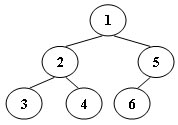An inorder binary tree traversal can be implemented in a non-recursive way with a stack. For example, suppose that when a 6-node binary tree (with the keys numbered from 1 to 6) is traversed, the stack operations are: push(1); push(2); push(3); pop(); pop(); push(4); pop(); pop(); push(5); push(6); pop(); pop(). Then a unique binary tree (shown in Figure 1) can be generated from this sequence of operations. Your task is to give the postorder traversal sequence of this tree.

Each input file contains one test case. For each case, the first line contains a positive integer N (≤) which is the total number of nodes in a tree (and hence the nodes are numbered from 1 to N). Then 2 lines follow, each describes a stack operation in the format: "Push X" where X is the index of the node being pushed onto the stack; or "Pop" meaning to pop one node from the stack.
For each test case, print the postorder traversal sequence of the corresponding tree in one line. A solution is guaranteed to exist. All the numbers must be separated by exactly one space, and there must be no extra space at the end of the line.
6
Push 1
Push 2
Push 3
Pop
Pop
Push 4
Pop
Pop
Push 5
Push 6
Pop
Pop3 4 2 6 5 1
#include<bits/stdc++.h> using namespace std; const int maxn=1010; #define inf 0x3fffffff stack<int> s; vector<int> pre; vector<int> mid; vector<int> post; void toPost(int root,int left,int right){//root为先序中根节点的下标,left和right分别为中序中子树的左右边界 if(left>right){ return ; } int i=left; while(i<right&&mid[i]!=pre[root]){ i++; } toPost(root+1,left,i-1); toPost(root+1+i-left,i+1,right); post.push_back(pre[root]); } int main(){ int n; scanf("%d",&n); int cnt=0; do{ string ss; getline(cin,ss); if(ss[1]==‘u‘){ ss=ss.substr(5); int ds=ss[0]-‘0‘; s.push(ds); pre.push_back(ds); } else if(ss[1]==‘o‘){ int k=s.top(); mid.push_back(k); s.pop(); cnt++; } }while(cnt<n); toPost(0,0,n-1); for(int i=0;i<n;i++){ if(i==n-1){ printf("%d\n",post[i]); } else{ printf("%d ",post[i]); } } return 0; }
不太理解由先序和中序确定后序的代码逻辑。。。明天好好研究
1086 Tree Traversals Again (25 分)
原文:https://www.cnblogs.com/dreamzj/p/14433801.html